
Welcome to Hyperion Records, a British classical label devoted to presenting high-quality recordings of music of all styles and from all periods from the twelfth century to the twenty-first.
Hyperion offers both CDs, and downloads in a number of formats. The site is also available in several languages.
Please use the dropdown buttons to set your preferred options, or use the checkbox to accept the defaults.

| Jonathan Morton (violin), Scottish Ensemble» More |
| Kati Debretzeni (violin), Orchestra of the Age of Enlightenment» More |
| Kerenza Peacock (violin), Trafalgar Sinfonia, Ivor Setterfield (conductor)» More |
| Orchestra of the Swan, David Le Page (violin)» More |
| La Serenissima, Adrian Chandler (conductor)» More |
| Janine Jansen (violin), Candida Thompson (violin), Henk Rubingh (violin), Julian Rachlin (viola), Maarten Jansen (cello), Stacey Richard Watton (double bass), Elizabeth Kenny (theorbo), Jan Jansen (harpsichord/organ)» More |
| Jacob Reuven (mandolin), Omer Meir Wellber (accordion), Sinfonietta Leipzig, Omer Meir Wellber (conductor)» More |
| Adelina Oprean (violin), European Union Chamber Orchestra, Jörg Faerber (conductor)» More |
While it is tempting for us to assume that most of Vivaldi’s creative energies as a performer-composer were concentrated on either the Pietà or the opera house, many of his diverse concertos must have originated elsewhere. During his lifetime twelve sets of chamber and orchestral music were printed with opus numbers. The first two sets—the Op 1 trio sonatas (1705) and Op 2 violin sonatas (1709)—were both published in Venice, but thereafter all of Vivaldi’s printed collections were produced in Amsterdam. L’estro armonico (‘Harmonic whim’, Op 3, 1711) and La stravaganza (‘Extravagance’, Op 4, 1716) appear to have been close collaborations with the Huguenot refugee Estienne Roger (1665/6-1722). However, it appears that the next three Vivaldi opuses were organized by the engraver and printer without the composer’s involvement, but featuring the imprint of Roger’s daughter Jeanne (1701-1722): a collection of solo and trio sonatas (Op 5, 1716), six violin concertos (Op 6, 1719), and twelve concertos for various instruments (Op 7, 1720, featuring at least three spurious works).
In the mid-1720s Vivaldi recommenced a closer partnership with Roger’s son-in-law and eventual successor Michel-Charles Le Cène (1683/4-1743, married to Roger’s elder but less favourite daughter Françoise). The first fruit of this renewed contact between Venice and Amsterdam was the publication of Il cimento dell’armonia e dell’inventione (‘The test of harmony and invention’, Op 8, 1725), comprising twelve violin concertos in four and five parts—the first four of them constituting Le quattro stagioni. Vivaldi dedicated the collection to Count Wenzel von Morzin (1675-1737), who was Lord Chamberlain to the Holy Roman Emperor Charles VI and a distant cousin of Haydn’s first employer Karl Joseph Franz Morzin. Most likely the Red Priest’s first patron north of the Alps, the Bohemian nobleman accompanied his two sons on their Grand Tour in 1718, when he probably first met Vivaldi in either Venice or Mantua. Morzin employed an orchestra at his main residence in Prague, and the count’s household accounts confirm that he certainly received concertos from the composer from 1719 until about 1728; his short-term resident music director Johann Friedrich Fasch apparently took copies of several Vivaldi concertos with him when he moved to become Kapellmeister at the Zerbst court in 1722, and in 1723 the count passed some on to Duke Anton Ulrich of Saxe-Meiningen (a nephew of Charles VI, and later also one of Vivaldi’s patrons).
Vivaldi identifies himself on the title page of Op 8 as the holder of three prestigious positions: Count Morzin’s ‘maestro di musica in Italia’ (presumably sending fresh compositions to Prague on an occasional basis), ‘maestro di concerti’ of the Ospedale della Pietà (the concertos are unlikely to have any connection to Vivaldi’s shifting connections with the Venetian institution), and ‘maestro di capella da camera’ to Prince Philip of Hesse-Darmstadt (a role Vivaldi appears to have fulfilled in 1718-20 during the prince’s period as imperial governor of the Duchy of Mantua). The composer’s dedicatory epistle reveals that his relationship with Morzin had already existed ‘for many years’, and that Le quattro stagioni had been received by the count and his ‘most accomplished orchestra’ some time ago. Vivaldi’s preface observed meekly:
Pray do not be surprised if, among these few and feeble concertos, Your Most Illustrious Lordship finds the Four Seasons which have so long enjoyed the indulgence of Your Most Illustrious Lordship’s kind generosity, but believe that I have considered it fitting to print them because, while they may be the same, I have added to them, besides the sonnets, a very clear statement of all things that unfold in them, so that I am sure that they will appear new to you.
Seemingly not always part of Le quattro stagioni when the concertos had been first disseminated in manuscript copies, each sonetto dimostrativo had seven or eight letters printed in the margins (except the complex imagery in ‘Winter’, which has twelve), and these were associated with cues, quotations from the verse, and extra rubrics in the part-books—not only in the principal violin part, but also sometimes elsewhere (for instance, the viola part clarifies that a dog is barking next to a sleepy shepherd).
The anonymous authorship of the sonnets has led to understandable but unprovable speculation that Vivaldi was their author. Nevertheless, the poems are somewhat clumsy in their literary fluency, and certain terms are blatantly in Venetian dialect or spelling. Paul Everett has pointed out that the balanced contrasts of moods and details in the depictions of humankind’s nuanced places within nature have some coincidental parallels with John Milton’s early poems L’allegro and Il penseroso (written in the early 1630s), juxtaposing mirth and melancholy. In a nutshell, ‘Spring’ and ‘Autumn’ show nature to be idyllic and nurturing to rural people (Arcadian shepherds and shepherdesses in ‘Spring’, bucolic hunters and Bacchian revellers in ‘Autumn’), whereas there is relative realism in the turbulence and destruction of ‘Summer’ (an individual’s futility in the face of a violent storm that destroys the year’s crops). In conclusion, ‘Winter’ shows that despite bitter cold, rain or freezing conditions, people can enjoy the pleasure of sitting inside by a roaring fire, or the giddy exhilaration of ice-skating (occasionally possible in Venice when the lagoon froze during severe winters).
from notes by David Vickers © 2022
Même si l’on aurait tendance à supposer que l’activité créatrice de Vivaldi, tant comme interprète que comme compositeur, se concentra sur la Pietà ou sur le théâtre lyrique, un grand nombre de ses divers concertos doivent provenir d’ailleurs. De son vivant, douze recueils de musique de chambre et de musique pour orchestre furent imprimés avec des numéros d’opus. Les deux premiers—les sonates en trio, op.1 (1705), et les sonates pour violon, op.2 (1709), furent tous deux publiés à Venise, mais, par la suite, tous les recueils imprimés de Vivaldi furent édités à Amsterdam. L’estro armonico («L’invention harmonique», op.3, 1711) et La stravaganza («L’extravagance», op.4, 1716) semblent avoir été réalisés en étroite collaboration avec Estienne Roger (1665/6-1722), un réfugié huguenot. Cependant, il semble que les trois opus de Vivaldi suivants aient été préparés par le graveur et imprimeur sans l’implication du compositeur, mais avec la marque d’éditeur de la fille d’Estienne Roger, Jeanne (1701-1722): un recueil de sonates en solo et en trio (op.5, 1716), six concertos pour violon (op.6, 1719) et douze concertos pour divers instruments (op.7, 1720, parmi lesquels figurent au moins trois œuvres apocryphes).
Au milieu des années 1720, Vivaldi reprit une collaboration plus étroite avec le gendre de Roger, qui finit par être son successeur Michel-Charles Le Cène (1683/4-1743, mari de Françoise, la fille aîné de Roger qui n’était pas sa préférée). Le premier fruit de ce contact renouvelé entre Venise et Amsterdam fut la publication d’Il cimento dell’armonia e dell’inventione («La confrontation entre l’harmonie et l’invention», op.8, 1725), recueil de douze concertos pour violon à quatre et cinq parties—les quatre premiers constituant Le quattro stagioni («Les quatre saisons»). Vivaldi dédia ce recueil au comte Wenzel von Morzin (1675-1737), qui était Chambellan de Charles VI, l’empereur du Saint Empire romain germanique, et un cousin éloigné du premier employeur de Haydn, Karl Joseph Franz Morzin. Ce noble Bohémien, très probablement le premier mécène du Prêtre rouge au nord des Alpes, accompagna ses deux fils dans leur tour d’Europe en 1718. C’est sans doute à cette occasion qu’il fit la connaissance de Vivaldi à Venise ou à Mantoue. Morzin employait un orchestre dans sa résidence principale de Prague et les comptes de la maisonnée confirment qu’il reçut certainement des concertos du compositeur à partir de 1719 jusqu’en 1728 environ; Johann Friedrich Fasch, qui fut son maître de chapelle résident pendant peu de temps, emporta apparemment avec lui des exemplaires de plusieurs concertos de Vivaldi lorsqu’il partit pour la cour de Zerbst en 1722, où il avait été nommé Kapellmeister et, en 1723, le comte en donna certains au duc Anton Ulrich de Saxe-Meiningen (un neveu de Charles VI, puis également l’un des mécènes de Vivaldi).
Sur la page de titre de l’op.8, Vivaldi s’identifie comme le titulaire de trois postes prestigieux: «maestro di musica in Italia» du comte Morzin (envoyant sans doute de nouvelles compositions à Prague à titre occasionnel), «maestro di concerti» de l’Ospedale della Pietà (il est peu probable que les concertos aient la moindre relation avec les liens intermittents de Vivaldi avec cette institution vénitienne), et «maestro di capella da camera» du prince Philippe de Hesse-Darmstadt (fonction que Vivaldi semble avoir occupée en 1718-20 lorsque le prince était gouverneur impérial du Duché de Mantoue). L’épître dédicatoire du compositeur révèle que ses relations avec Morzin existaient déjà «depuis de nombreuses années» et que Le quattro stagioni avait été reçues depuis longtemps par le comte et son «orchestre très accompli». La préface de Vivaldi fait observer docilement:
Ne soyez pas surpris, je vous prie, si, parmi ces quelques faibles concertos, votre très Illustre Seigneurie retrouvera les Quatre saisons qu’elle a accueillies autrefois avec une très généreuse bonté, mais croyez que j’ai jugé bon de les imprimer car, si elle restent les mêmes, je leur ai ajouté, en plus des sonnets, une explication détaillée de toutes les péripéties, je suis sûr qu’ils vous sembleront nouveaux.
Lorsque les concertos furent diffusés sous forme d’exemplaires manuscrits, il semble que les sonnets ne faisaient pas systématiquement partie des Quatre saisons. Chaque sonetto dimostrativo comportait en marge sept ou huit lettres imprimées (à l’exception de l’imagerie complexe de «L’hiver», qui en a douze), et celles-ci correspondaient à des repères, des citations de vers, et des rubriques supplémentaires dans les livres de parties séparées—pas seulement dans la partie principale de violon, mais aussi parfois ailleurs (par exemple, l’indication d’un chien qui aboie près d’un berger endormi figure à la partie d’alto).
La paternité anonyme des sonnets a donné lieu à une spéculation bien naturelle mais impossible à prouver selon laquelle Vivaldi en aurait été l’auteur. Néanmoins, les poèmes sont un peu gauches dans leur fluidité littéraire, et certains termes sont manifestement en dialecte ou orthographe vénitiens. Le spécialiste de Vivaldi, Paul Everett a fait remarquer que l’équilibre des contrastes d’atmosphère et de détails dans les descriptions d’endroits nuancés de l’humanité au sein de la nature présentent certaines analogies fortuites avec les premiers poèmes de John Milton L’allegro et Il penseroso (écrits au début des années 1630), où se juxtaposent joie et mélancolie. En un mot, «Le printemps» et «L’automne» montrent que la nature est idyllique et nourrissante pour les populations rurales (les bergers et bergères arcadiens dans «Le printemps», les chasseurs bucoliques et les fêtards adeptes de Bacchus dans «L’automne»), alors qu’il y a un réalisme relatif dans la turbulence et la destruction de «L’été» (l’inutilité de l’individu face à une violente tempête qui détruit les cultures de l’année). En conclusion, «L’hiver» montre que malgré un froid mordant, la pluie ou des conditions climatiques glaciales, les gens peuvent jouir du plaisir de rester assis à l’intérieur près d’un bon feu de cheminée, ou de l’euphorie enivrante du patinage sur glace (ce qui est parfois possible à Venise lorsque le lagon gèle au cours d’hivers sévères).
extrait des notes rédigées par David Vickers © 2022
Français: Marie-Stella Pâris
Zwar liegt die Annahme nahe, dass Vivaldi als Interpret und Komponist hauptsächlich für das Ospedale oder die Oper schuf. Doch müssen die Ursprünge vieler seiner Concerti anderswo liegen. Zu seinen Lebzeiten erschienen zwölf Sammeldrucke mit Kammer- und Orchesterwerken unter eigenen Opuszahlen. Die ersten beiden, die Triosonaten Opus 1 (1705) und die Violinsonaten Opus 2 (1709), erschienen beide in Venedig; danach jedoch kamen alle verbleibenden Sammeldrucke in Amsterdam heraus. L’estro armonico („Die harmonische Laune“, Opus 3 von 1711) und La stravaganza (Opus 4 von 1716) scheinen in enger Zusammenarbeit mit dem Verleger Estienne Roger (1665/6-1722) entstanden zu sein, der als Hugenotte aus Frankreich geflohen war. Die nächsten drei Druckwerke allerdings wurden offenbar von Notenstecher und Drucker ohne Mitwirkung des Komponisten erstellt. Sie tragen das Zeichen von Rogers Tochter Jeanne (1701-1722): eine Sammlung aus Solo- und Triosonaten (Opus 5, 1716), sechs Violinkonzerte (Opus 6, 1719) und zwölf Konzerte für verschiedene Instrumente (Opus 7, 1720), darunter mindestens drei von zweifelhafter Zuschreibung.
Mitte der 1720er-Jahre ging Vivaldi eine enge Zusammenarbeit mit dem Schwiegersohn und möglichen Nachfolger Rogers ein, mit Michel-Charles Le Cène (1683/4-1743, verheiratet mit der älteren, aber zurückgesetzten Tochter Françoise). Die erste Frucht des erneuerten Vertrags zwischen Venedig und Amsterdam war der Druck von Il cimento dell’armonia e dell’inventione („Probe von Harmonie und Erfindungsgabe“, Opus 8, 1725) mit zwölf Violinkonzerten zu vier und fünf Stimmen. Die ersten vier bilden Le quattro stagioni. Vivaldi widmete die Sammlung dem Grafen Wenzel von Morzin (1675-1737), Oberhofmeister des Kaisers des Heiligen Römischen Reichs Karls VI. und entfernt verwandt mit Karl Joseph Franz Morzin, dem ersten Dienstherrn Haydns. Dieser böhmische Adelige, wohl der erste Mäzen Vivaldis nördlich der Alpen, begleitete 1718 zwei seiner Söhne auf die „Grand Tour“ und lernte dabei in Venedig oder Mantua Vivaldi kennen. An seiner Hauptresidenz in Prag hielt sich Graf Morzin ein Orchester; die Rechnungsbücher seines Hauses belegen, dass er von 1719 bis etwa 1728 Concerti von Vivaldi ankaufte. Eine kurze Zeit diente ihm Johann Friedrich Fasch als Kapellmeister, und offenbar nahm er Abschriften etlicher Vivaldi-Concerti mit nach Zerbst, wo er 1722 Hofkapellmeister wurde; 1723 sandte Graf Morzin einige weitere an Herzog Ulrich von Sachsen-Meiningen (einen Neffen Karls VI. und später ebenfalls Förderer Vivaldis).
Auf dem Titelblatt des Opus 8 weist sich Vivaldi mit drei beachtlichen Titeln aus: als „maestro di musica in Italia“ des Grafen Morzin (den er wohl gelegentlich mit neuen Kompositionen belieferte), als „maestro di concerti“ des Ospedale della Pietà (wobei die Concerti wohl kaum mit den wechselnden Beziehungen Vivaldis zu dieser Einrichtung zu tun hatten) und als „maestro di capella“ des Prinzen Philipp von Hessen-Darmstadt (eine Stellung, die Vivaldi offenbar von 1718 bis 1720 innehatte, als der Prinz als kaiserlicher Gouverneur des Herzogtums Mantua diente). Die ausführliche Widmung des Komponisten offenbart, dass die Beziehung zu Morzin bereits „seit vielen Jahren“ bestehe und dass der Prinz und sein „vollkommenes Orchester“ Le quattro stagioni bereits vor einiger Zeit erhalten hätten. In untertänigem Ton heißt es in Vivaldis Vorrede:
Seid bitte nicht verwundert, wenn Seine erlauchteste Hoheit unter diesen wenigen und armseligen Concerti auch die Vier Jahreszeiten vorfinden, die sich bereits so lang der Gnade Eurer milden Großmut erfreuen. Doch mögt Ihr mir glauben, dass ich ihre Veröffentlichung reiflich überlegt habe, denn mögen jene auch dieselben sein, so habe ich ihnen doch, außer den Sonetten, eine überaus deutliche Beschreibung aller Dinge beigegeben, die in ihnen geschehen. So bin ich denn gewiss, dass sie Euch neu erscheinen.
Waren die sonnetti dimostrativi also wohl nicht in allen Abschriften aus der ersten Verbreitungsphase der Quattro stagioni enthalten, so waren zu den Sonetten nun sieben oder acht Buchstaben an den Rand gesetzt (außer im komplexeren „Winter“ mit zwölf Buchstaben); diese wiederum waren Stichworten, Zitaten aus den Gedichten und Anmerkungen in den Stimmbüchern zugeordnet—nicht nur in der Stimme des violino principale, sondern bisweilen auch in anderen Partien (so erscheint in der Bratschenstimme die Erläuterung, dass neben dem schläfrigen Schäfer ein Hund belle).
Dass die Sonette nicht den Namen des Dichters nennen, führte zu der verständlichen, aber nicht belegbaren Annahme, Vivaldi selber sei der Verfasser. Allerdings ist ihr Duktus tatsächlich etwas ungelenk, und sie enthalten Wendungen, die offenkundig dem venezianischen Dialekt entstammen. Der Vivaldi-Forscher Paul Everett weist darauf hin, dass die wohlabgewogenen Stimmungskontraste und Einzelheiten in der Darstellung des Verhältnisses von Mensch und Natur Parallelen zu den frühen Gedichten L’allegro und Il penseroso von John Milton aufwiesen, entstanden Anfang der 1630er-Jahre, die sich zwischen Heiterkeit und Melancholie entfalten. Kurz gesagt, zeigen „Frühling“ und „Herbst“ eine idyllische Natur, die das Landvolk nährt (arkadische Schäfer und Schäferinnen im „Frühling“, ländliche Jäger und Bacchus-Jünger im „Herbst“); verhältnismäßig realistisch erscheint dagegen die zerstörerische Gewalt des „Sommers“ (die Hilflosigkeit des Einzelnen angesichts eines heftigen Sturms, der die Ernte vernichtet). Der „Winter“ schließlich zeigt, dass der Mensch auch angesichts bitteren Frostes, Regens und Eises Genuss darin findet, im Haus am prasselnden Feuer zu sitzen oder sich am Schlittschuhlaufen zu erfreuen (wie es manchmal in Venedig möglich war, wenn ein strenger Winter die Lagune zufrieren ließ).
aus dem Begleittext von David Vickers © 2022
Deutsch: Friedrich Sprondel
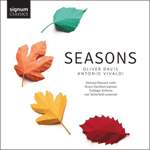 Davis (O) & Vivaldi: Seasons Davis (O) & Vivaldi: SeasonsTwo creative responses to a quartet of anonymous Renaissance sonnets, one impossibly famous, the other newly composed.» More |
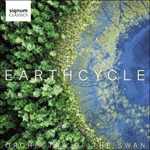 Earthcycle EarthcycleAnother refreshingly different mix-tape album which draws together its strands in a quartet of tableaux having at their heart Vivaldi's perennial masterpiece.» More |
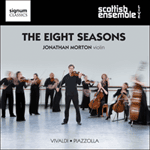 Vivaldi & Piazzolla: The Eight Seasons Vivaldi & Piazzolla: The Eight SeasonsCombining Vivaldi's timeless Four Seasons with Piazzolla's tango-inspired The Four Seasons of Buenos Aires, this is a unique album from one of Scotland's most dynamic and versatile groups, the Scottish Ensemble, performing under dynamic Artistic D ...» More |
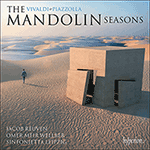 Vivaldi & Piazzolla: The mandolin seasons Vivaldi & Piazzolla: The mandolin seasonsA mandolin for all seasons—Vivaldi and Piazzolla as you’ve never heard them before.» More |
 Vivaldi: Opus 8 Vol. 1 Vivaldi: Opus 8 Vol. 1Recognized for ‘whipping up a storm with Vivaldi’, La Serenissima is ‘one of Britain’s best-loved chamber orchestras’ (The Telegraph), and this new recording of The Four Seasons is everything one might expect. ‘After being obsessed by the composer ...» More |
 Vivaldi: The Four Seasons Vivaldi: The Four SeasonsViolinist Janine Jansen’s recording of Vivaldi’s Four Seasons topped international charts when it was first released. Recorded with an intimate chamber ensemble, Jansen brings fresh vigour and imagination to these well-known works.» More |
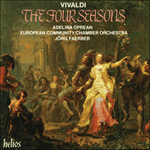 Vivaldi: The Four Seasons Vivaldi: The Four Seasons |
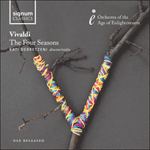 Vivaldi: The Four Seasons Vivaldi: The Four SeasonsWith its vivid poetry and technical ingenuity, Vivaldi’s Four Seasons was ground breaking at the time of its release and to this day remains as influential and transfixing as ever. In this recording, violinist Kati Debretzeni directs the Orchestra ...» More |

